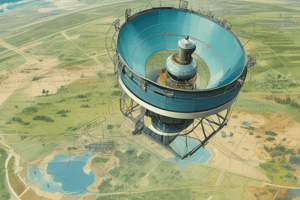Podcast
Questions and Answers
What determines the distance to the target in non-imaging microwave sensors?
What determines the distance to the target in non-imaging microwave sensors?
- The strength of the backscattered signal
- The surface properties of the target
- The angle at which the microwave energy strikes the target
- The time delay between transmitted and reflected signals (correct)
What is the primary function of scatterometers?
What is the primary function of scatterometers?
- Determining aircraft altitude
- Detecting objects at a distance
- Estimating wind speeds based on sea surface roughness (correct)
- Mapping topographic features of land
Which microwave sensor is used for altitude determination in aircraft?
Which microwave sensor is used for altitude determination in aircraft?
- Ground-based pulsed radar
- Synthetic aperture radar
- Scatterometer
- Radar altimeter (correct)
Who achieved the first demonstration of the transmission and reflection of radio microwaves?
Who achieved the first demonstration of the transmission and reflection of radio microwaves?
What technology was developed after World War II for military reconnaissance?
What technology was developed after World War II for military reconnaissance?
What decade marked the declassification of military radars that allowed for civilian mapping applications?
What decade marked the declassification of military radars that allowed for civilian mapping applications?
What factor affects the amount of backscattered energy detected by scatterometers?
What factor affects the amount of backscattered energy detected by scatterometers?
Which component was a focus of development in the 1920s and 1930s for detecting objects at a distance?
Which component was a focus of development in the 1920s and 1930s for detecting objects at a distance?
Which polarization combination is classified as cross-polarized?
Which polarization combination is classified as cross-polarized?
What type of radar system measures the phase difference between the channels?
What type of radar system measures the phase difference between the channels?
How does pulse length affect range resolution in radar systems?
How does pulse length affect range resolution in radar systems?
Which combination represents dual polarization in radar systems?
Which combination represents dual polarization in radar systems?
What is the primary characteristic of microwaves that differentiates them from visible and infrared radiation?
What is the primary characteristic of microwaves that differentiates them from visible and infrared radiation?
What is the relationship between the microwave pulse duration and range resolution?
What is the relationship between the microwave pulse duration and range resolution?
Which type of microwave sensor collects naturally emitted radiation?
Which type of microwave sensor collects naturally emitted radiation?
In which application is passive microwave remote sensing commonly used?
In which application is passive microwave remote sensing commonly used?
What is the function of imaging active microwave sensors?
What is the function of imaging active microwave sensors?
Which of the following correctly describes the energy captured by passive microwave sensors?
Which of the following correctly describes the energy captured by passive microwave sensors?
What distinguishes active microwave sensors from passive ones?
What distinguishes active microwave sensors from passive ones?
What is the function of RADAR in the context of microwave remote sensing?
What is the function of RADAR in the context of microwave remote sensing?
Which feature is a disadvantage of passive microwave sensors?
Which feature is a disadvantage of passive microwave sensors?
What is the term used for the terrain closest to the aircraft in the line of sight?
What is the term used for the terrain closest to the aircraft in the line of sight?
In the context of radar, what does the depression angle refer to?
In the context of radar, what does the depression angle refer to?
How is incident angle defined in radar systems?
How is incident angle defined in radar systems?
What is the primary function of polarization in radar systems?
What is the primary function of polarization in radar systems?
What type of radiation do many radars transmit?
What type of radiation do many radars transmit?
Which of the following describes backscattered waves in radar systems?
Which of the following describes backscattered waves in radar systems?
How can polarization be synthesized in radar systems?
How can polarization be synthesized in radar systems?
What essential aspect of radar polarimetry is analyzed?
What essential aspect of radar polarimetry is analyzed?
What is the primary difference between Real Aperture Radar and Synthetic Aperture Radar?
What is the primary difference between Real Aperture Radar and Synthetic Aperture Radar?
Which band has the shortest wavelength typically used in orbital and sub-orbital platforms?
Which band has the shortest wavelength typically used in orbital and sub-orbital platforms?
What is a significant characteristic of Ka-band radar?
What is a significant characteristic of Ka-band radar?
What does the duplexer in an Active Microwave System do?
What does the duplexer in an Active Microwave System do?
Which of the following applications is associated with the C-band in radar systems?
Which of the following applications is associated with the C-band in radar systems?
What does the term 'multiple-frequency radars' refer to?
What does the term 'multiple-frequency radars' refer to?
What common feature of microwave energy affects its measurement?
What common feature of microwave energy affects its measurement?
Which radar band is commonly referred to as a 'workhorse' for its extensive applications?
Which radar band is commonly referred to as a 'workhorse' for its extensive applications?
Which option describes the wavelength range of the S-band in radar applications?
Which option describes the wavelength range of the S-band in radar applications?
What is the typical application for Ku-band radar?
What is the typical application for Ku-band radar?
What factor affects azimuth resolution in real aperture radar?
What factor affects azimuth resolution in real aperture radar?
How is the azimuth resolution of a synthetic aperture radar (SAR) calculated?
How is the azimuth resolution of a synthetic aperture radar (SAR) calculated?
What phenomenon causes the grainy pattern in radar imagery known as speckle?
What phenomenon causes the grainy pattern in radar imagery known as speckle?
Which of the following is an effect of foreshortening in radar imagery?
Which of the following is an effect of foreshortening in radar imagery?
What causes the shadow effect in radar imagery?
What causes the shadow effect in radar imagery?
What is the relationship between antenna length and beam width in radar systems?
What is the relationship between antenna length and beam width in radar systems?
What influences relief displacement in radar imagery?
What influences relief displacement in radar imagery?
In radar terminology, what leads to image layover?
In radar terminology, what leads to image layover?
Flashcards
Microwave Radar
Microwave Radar
A sensor that transmits microwave signals to a target, measures the backscattered portion, and determines the target's distance based on the time delay.
Radar Altimeter
Radar Altimeter
A non-imaging microwave sensor that measures the round-trip time delay of short microwave pulses to determine a target's distance.
Scatterometer
Scatterometer
A non-imaging sensor that measures the amount of energy backscattered from a target, useful for analyzing surface properties like roughness.
Backscattered signal
Backscattered signal
Signup and view all the flashcards
Synthetic Aperture Radar (SAR)
Synthetic Aperture Radar (SAR)
Signup and view all the flashcards
Side-Looking Airborne Radar (SLAR)
Side-Looking Airborne Radar (SLAR)
Signup and view all the flashcards
Microwave Remote Sensing
Microwave Remote Sensing
Signup and view all the flashcards
Wavelength Penetration
Wavelength Penetration
Signup and view all the flashcards
Passive Microwave Sensors
Passive Microwave Sensors
Signup and view all the flashcards
Passive Microwave Radiometer
Passive Microwave Radiometer
Signup and view all the flashcards
Active Microwave Sensors
Active Microwave Sensors
Signup and view all the flashcards
RADAR
RADAR
Signup and view all the flashcards
Imaging Active Sensors
Imaging Active Sensors
Signup and view all the flashcards
Non-Imaging Active Sensors
Non-Imaging Active Sensors
Signup and view all the flashcards
Applications of Passive Microwave Sensing
Applications of Passive Microwave Sensing
Signup and view all the flashcards
Low Spatial Resolution
Low Spatial Resolution
Signup and view all the flashcards
Real Aperture Radar (RAR)
Real Aperture Radar (RAR)
Signup and view all the flashcards
Synthetic Aperture Radar (SAR)
Synthetic Aperture Radar (SAR)
Signup and view all the flashcards
SAR Resolution
SAR Resolution
Signup and view all the flashcards
Microwave Systems Components
Microwave Systems Components
Signup and view all the flashcards
Radar Wavelengths
Radar Wavelengths
Signup and view all the flashcards
Radar Wavelength Units
Radar Wavelength Units
Signup and view all the flashcards
Radar Band Names
Radar Band Names
Signup and view all the flashcards
K-band
K-band
Signup and view all the flashcards
X-band
X-band
Signup and view all the flashcards
Multiple-Frequency Radars
Multiple-Frequency Radars
Signup and view all the flashcards
Ka, K, Ku, X, C, S, L Bands
Ka, K, Ku, X, C, S, L Bands
Signup and view all the flashcards
Vegetation Mapping
Vegetation Mapping
Signup and view all the flashcards
SAR
SAR
Signup and view all the flashcards
Azimuth Direction
Azimuth Direction
Signup and view all the flashcards
Range/Look Direction
Range/Look Direction
Signup and view all the flashcards
Near Range
Near Range
Signup and view all the flashcards
Far Range
Far Range
Signup and view all the flashcards
Depression Angle
Depression Angle
Signup and view all the flashcards
Look Angle
Look Angle
Signup and view all the flashcards
Incident Angle
Incident Angle
Signup and view all the flashcards
Polarization
Polarization
Signup and view all the flashcards
Polarimetry
Polarimetry
Signup and view all the flashcards
Polarization Combinations
Polarization Combinations
Signup and view all the flashcards
Like-Polarization
Like-Polarization
Signup and view all the flashcards
Cross-Polarization
Cross-Polarization
Signup and view all the flashcards
Single-Polarization
Single-Polarization
Signup and view all the flashcards
Dual-Polarization
Dual-Polarization
Signup and view all the flashcards
Quadrature Polarization
Quadrature Polarization
Signup and view all the flashcards
Radar Range Resolution
Radar Range Resolution
Signup and view all the flashcards
Microwave Pulse Length
Microwave Pulse Length
Signup and view all the flashcards
Radar Resolution
Radar Resolution
Signup and view all the flashcards
Azimuth Resolution
Azimuth Resolution
Signup and view all the flashcards
Range Resolution
Range Resolution
Signup and view all the flashcards
Real Aperture Radar Beam Width
Real Aperture Radar Beam Width
Signup and view all the flashcards
SAR Azimuth Resolution
SAR Azimuth Resolution
Signup and view all the flashcards
Speckle
Speckle
Signup and view all the flashcards
Relief Displacement
Relief Displacement
Signup and view all the flashcards
Foreshortening
Foreshortening
Signup and view all the flashcards
Layover
Layover
Signup and view all the flashcards
Shadow in Radar
Shadow in Radar
Signup and view all the flashcards
Study Notes
Microwave Remote Sensing
- Microwave remote sensing employs electromagnetic radiation with wavelengths between 1 cm and 1 m (microwaves).
- Microwaves penetrate clouds, fog, and ash/powder effectively, unlike visible and infrared radiation. This facilitates observations in challenging atmospheric conditions (e.g., volcanic eruptions, collapsed buildings).
- Microwave remote sensing systems are categorized into passive and active systems.
Passive Microwave Systems
- Passive systems detect naturally emitted microwave energy from surfaces.
- The emitted energy correlates with the temperature and moisture content of the emitting object/surface.
- Microwave energy, emitted, reflected, or transmitted from the surface or atmosphere can be recorded.
Active Microwave Systems
- Active microwave systems generate their own microwave radiation signal, directing it toward the target and measuring the backscattered portion.
- This principle determines range and allows differentiation among targets.
- This category includes radars, mainly divided into imaging and non-imaging systems.
RADAR (Radio Detection And Ranging)
- RADAR is the most prevalent imaging system.
- It sends a microwave signal, measures the backscattered portion, distinguishes among targets, and calculates distance via signal delay.
Non-Imaging Microwave Systems
- Non-imaging systems encompass altimeters and scatterometers.
- Altimeters measure the time delay of microwave pulses to determine the distance of targets from the sensor.
- Scatterometers quantify backscattered energy from targets based on surface properties and the incident angle of the microwave (roughness is a key factor.)
Development of Active Microwave Remote Sensing
- The first demonstrations of microwave transmission and reflection from objects date back to 1886 (Heinrich Hertz).
- Early radar systems were primarily for detecting ships.
- Ground-based pulsed radar systems were developed in the 1920s and 1930s for distant object detection.
- World War II saw advancements in imaging radars to detect and locate aircraft and ships.
- Side-looking airborne radar (SLAR) systems emerged after WWII to map extensive terrain from airborne platforms.
- Synthetic aperture radar (SAR) developed in the 1950s enhanced image resolution.
- These technologies were later declassified and applied to civilian applications.
SAR (Synthetic Aperture Radar)
- Two kinds of SAR: Real Aperture Radar and Synthetic Aperture Radar.
- Real Aperture Radar (brute-force radar) employs a fixed antenna length.
- Synthetic Aperture Radar leverages a smaller antenna, but computationally constructs a larger virtual antenna to achieve high resolution from a distance.
- 11m wide SAR antenna in a satellite system can generate a long synthetic antenna, simulating a much longer one.
Active Microwave System Components
- Active microwave systems consist of a pulse generator, transmitter, duplexer, antenna, and receiver.
- Recording devices (like high-density digital tape/hard disks) and CRT monitors assist in data recording/verification.
Wavelength, Frequency, and Pulse Length
- Microwave radiation emitted by radar systems has certain wavelengths and durations.
- Wavelengths are often measured in centimetres.
- Early naming conventions (due to World War II secrecy) employed alphabetic designations (e.g., K-bands). Shorterest wavelength (e.g., K-band ) can be absorbed by water vapor. Shorter wavelengths are often used in areas needing greater detail.
- Some radar systems use multiple frequencies.
Radar Band Designations
- A range of frequency bands (Ka to P) are used in microwave remote sensing; Each exhibits unique characteristics and optimal performance for specific applications.
Antenna, Azimuth, and Flight Direction
- Antennas are typically mounted beneath the aircraft for radar systems.
- Azimuth refers to the aircraft's direction of travel, used to locate the radar beam's path across the land.
- The plane (or satellite) flying is designed in such a way that the pulses illuminate strips of terrain at right or parallel angles to travel path. Pulses of energy illuminate a strip, often at right angles to the aircraft's direction of travel.
Range, Depression, and Incidence Angles
- Range is the distance from the sensor to the target.
- Depression Angle : the angle between a point at the surface of Earth and a line from the antenna to that point, projected onto the horizontal plane.
- Incident angle, is the angle between a line from the antenna to a point on the ground and a line perpendicular to that ground point.
Polarization
- Polarization describes the orientation of electromagnetic waves' vibrations within the radiation.
- Radars usually transmit, and receive linearly-polarized signals (e.g., horizontal or vertical polarization).
- Analysis of backscattered waves based on polarization combinations constitutes radar polarimetry.
Speckle
- Speckle in radar images is graininess or random variations due to the coherent nature of the radar signals (interference).
- Speckle can be mitigated using techniques like multi-look processing.
Relief Displacement (Foreshortening and Layover)
- Relief displacement, refers to the horizontal shifts in an object's position in the image due to elevation.
- Foreshortening and layover are two phenomena that are important to consider when analyzing radar images.
Range and Azimuth Resolution
- Range resolution is affected by the pulse duration of the microwave.
- Azimuth resolution depends on the width of the radar beam and the antenna length.
- Shorter wavelengths lead to improved resolution.
Studying That Suits You
Use AI to generate personalized quizzes and flashcards to suit your learning preferences.




